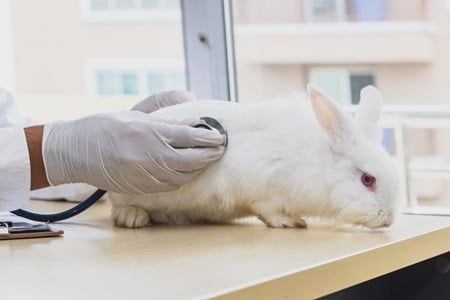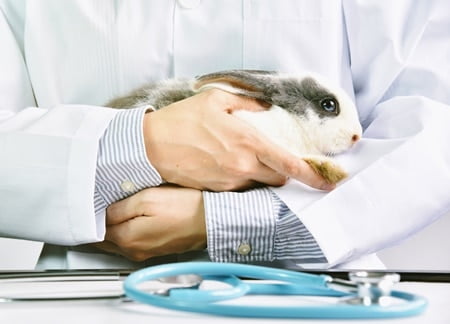Rabbits cannot verbally tell us about their discomfort, so pain can be very difficult to identify. Pain perception is similar in all animals. Therefore, treating pain is crucial because it diminishes your pet rabbit’s quality of life.
Pain in rabbits can be treated naturally or medically, depending on the cause. NSAIDs are used for chronic pain, and narcotics, such as opioids, may be used for pre-surgery or post-surgery pain. Local anesthetics are administered for minor surgical procedures, such as skin biopsies. Natural pain treatments include acupuncture and massage.
Pain is almost always a sign of an underlying health issue that needs treatment. Identifying pain allows your vet to make an accurate diagnosis, treat pain to relieve stress, and enables your rabbit to recover faster.
How To Treat Pain in Rabbits
There are many analgesic choices for rabbits, which can be used depending on the cause and severity of the pain. Some methods involve the use of drugs or drug combinations, while others are more natural.
Rabbits experience physical pain in the same way humans do. Rabbits are also incredibly vulnerable to stress. Therefore, if moderate-to-severe pain isn’t managed appropriately, it can have serious consequences.
Pain relief can improve the quality of your rabbit’s life and increase its chances of recovering from treatment. Pain management is used for:
- Dental disease
- Gastrointestinal disease
- Trauma
- Arthritis
- Surgical intervention
Drugs, such as aspirin, may be used to treat mild-to-moderate chronic pain. If a rabbit needs to be hospitalized, your vet may opt for drugs that reduce anxiety in conjunction with pain medication. Buprenorphine is a type of opioid medication that may be used to relieve discomfort before, during, or after a surgical procedure.

Keep in mind that there are no drugs that are specifically designed for rabbits, but many pain relievers have been evaluated for rabbits with appropriate dosages.
If you suspect your rabbit is hurting, take it to a vet immediately. Your vet will decide on the optimal method of pain management.
What Are the Classes of Pain Relief Drugs for Rabbits?
Your veterinarian will recommend an appropriate plan to relieve your rabbit’s pain following a diagnosis. A veterinarian checkup will also ensure that the underlying cause of the pain is also promptly treated.
The most common types of pain relief drugs used for rabbits include:
Non-Steroidal Anti-inflammatory Drugs (NSAIDs)
These include ibuprofen, flunixin meglumine, aspirin, carprofen, and meloxicam. They’re commonly used to treat pain, inflammation, and swelling in rabbits.
NSAIDs are the most common pain-relieving drugs used for chronic pain in rabbits. They have anti-inflammatory and pain-relieving properties, so they’re often chosen for mild to moderate pain in rabbits.
These drugs can be given orally or via injection. They are also well-tolerated in rabbits for extended periods. The efficacy of different NSAIDs varies according to the type of drug, its dosage and the type of pain.
Aspirin may be needed in high dosages to relieve pain, but the drug is highly effective. Aspirin can be used at home after consulting with a vet. However, aspirin is also a blood thinner and should never be used before surgery, or if a rabbit has internal bleeding.
Long-term use of NSAIDs for rabbits should be approached with caution to avoid adverse side-effects in the kidneys and gastrointestinal tracts.
If your rabbit requires NSAIDs for chronic pain, such as for arthritis, your vet may re-examine your rabbit’s blood to ensure its organs are healthy.
Narcotics
Narcotics are a diverse group of opioid drugs, such as fentanyl. They are the strongest analgesics for pain treatment, often used for bone pain and for pre-surgical or post-surgical pain management.
Opioids are most commonly given via injection, but some can be administered orally or as a patch on the skin.
Most opioid drugs are controlled by the FDA and are rarely prescribed for home use for rabbits.
Local Anesthetics
Local anesthetics are administered in rabbits either in the form of drops, topical creams, or by injection into the skin.
Veterinarians commonly use local anesthetics before minor skin procedures, such as skin biopsies, IV catheter placement, ophthalmic procedures (thorough eye exam and tear duct flushing), nasophageal tube placement, and small tumor removals.
Local anesthetics are not to be used for long-term pain relief as their duration of action is short.
Epidural Anesthesia
Epidural anesthesia is administered by injecting an anesthetic into the spinal fluid. The rabbit will be sedated before performing epidural anesthesia.
The purpose of epidural anesthesia is to numb the site of injection down the spine. It’s commonly used when women are giving birth. In rabbits, it’s used to manage post-surgical pain following any abdominal surgical procedure, such as GI surgery.
Epidural anesthesia is a short-term anesthesia that is only administered in a veterinary clinic.
Note of Caution
Never try to develop your own home remedies or treatment plan for pain relief for your pet rabbit.
Each medication has side effects that can be damaging to a rabbit’s health.
You must ensure that your rabbit does not experience changes in its gastrointestinal motility, especially if it is stressed.
Pain Medications for Rabbits
| Name of Pain Medication | Dosage | Method and Frequency | Notes |
|---|---|---|---|
| Aspirin | 10-100 mg/kg (up to 400 mg/kg) | Orally once a day (up to 3 times a day) | Aspirin is a blood thinner Avoid aspirin if surgery is planned or in case of internal bleeding |
| Ibuprofen | 2-10 mg/kg | Orally, Once a day (up to 3 times a day) | May cause gastric irritation or ulceration |
| Carprofen | 1-2.2 mg/kg 2-4 mg/kg (for subcutaneous injection and IV) | Orally – twice a day Subcutaneous injection or intravenous injection (IV) – once a day | Effective during 12 to 24 hours |
| Flurbiprofen | 1 drop | Topically 2-3 times a day | Only for nose and eyes |
| Ketoprofen | 1-3 mg/kg | Intramuscular injection 1-2 times a day | Effective for 24 hours Will interact with diuretics and aspirin |
| Piroxicam | 0.3 mg/kg | Orally | – |
| Meloxicam | 0.3-0.6 mg/kg up to 1.5 mg/kg (for severe pain) | Orally, intramuscular injection or subcutaneous injection 1-2 times a day | Effective for 12 to 24 hours. Should not be used with other NSAIDs, corticosteroid or nephrotic drug. Should not be used if rabbit has kidney or liver failure. |
| Flunixin | 0.3-1.1 mg/kg | Orally, subcutaneous injection, intravenous injection or intramuscular injection 1-2 times a day | Effective for 12 to 24 hours Flunixin’s efficacy for pain relief in rabbits is questionable. |
| Fentanyl patches | 12.5 μg patch for a 3 kg rabbit | Topically | Patch should be covered to prevent ingestion. May cause drowsiness. |
| Tramadol | 5-10mg/kg, (up to 15mg/kg) for oral use 5mg/kg for Intravenous or subcutaneous injection | Orally – every 8 to 12 hours Intravenous or subcutaneous injection – every 8 hours | For moderate or chronic pain in rabbits. Higher doses (such as 10 mg/kg or higher) may cause drowsiness and depression of the central nervous system. |
| Morphin | 2-5 mg/kg | Subcutaneous or intramuscular injection | Effective for 2-3 hours. |
| Buprenorphine | 0.01-0.05 mg/kg | Intramuscular, intravenous or subcutaneous injection 2-4 times a day | Effective for 6-12 hours. May cause respiratory depression. May be used for post-surgical pain or to reverse opioid effects. |
| Butorphanol | 0.1-0.5 mg/kg | Intramuscular, intravenous or subcutaneous injection | Quick results in rabbits 2-hour effectiveness May be used for post-surgical pain or to reverse opioid effects |
| Hydromorphone | 0.1-0.2 mg/kg | Intravenous injection | For moderate-to-severe pain. |
| Meperidine (Pethidine) | 5-10 mg/kg | Subcutaneous or intramuscular injection | Used as a pre-anesthetic. |
| Nabulphine | 1-2 mg/kg | Intramuscular or intravenous injection | For post-surgical pain For reversing effects of opioids. |
| Pentazocine | 5-10 mg/kg | Subcutaneous or intramuscular injection | May be used for post-surgical pain or to reverse opioid effects. |
| Oxymorphone | 0.05-0.2 mg/kg | Subcutaneous or intramuscular injection | May be used as a pre-anesthetic. May cause bradycardia and respiratory depression. |
| Pethidine | 5-10 mg/kg | Intramuscular, intravenous or subcutaneous injection | – |
Natural Pain Relief for Rabbits
In most cases, pain relief requires the use of drugs. Most natural methods are used in conjunction with drug treatment to help your rabbit feel comfortable and to maximize recovery.
Some examples of natural pain management methods for rabbits include the following:
Comfort and Relaxation
Speak in soft tones and use proper nursing practices. Providing a comfortable home and hospital environment helps your rabbit to feel safe.
Pain is just one of the stress factors rabbits experience when they have a disease or trauma. Sick rabbits have to cope with their ailment, as well as the stressful changes that occur in their environment.
A sick rabbit is also separated from its human and rabbit companions. The vet (a stranger to your rabbit) may poke, palpate or move painful areas of the rabbit’s body, causing further stress to the animal. They may have to restrain your rabbit to perform blood work and other diagnostic tests.

Excessive noise, lack of safety and too much handling can intensify the pain and stress. Therefore, make sure your rabbit is soothed throughout the entire experience.
Minimize handling, keep the TV or other sound devices away from your rabbit’s living space and keep children and other pets (for e.g. barking dogs) away from your sick rabbit.
Having safe hiding spaces in your home, such as a cardboard box is another way to help your rabbit feel secure when needed.
Rabbits recover faster and respond better when they are returned to their home environment quickly following treatment.
Acupuncture
Acupuncture is a type of pain relief that dates back thousands of years. It has been used in animals for controlling pain from certain conditions.
Acupuncture may not work for all situations and is a form of therapy that requires further investigation for chronic conditions that cause pain, such as arthritis. For example, when a rabbit has stiff back legs.
Chiropractic or Acupressure Massage
Chiropractic or acupressure massage may aid in relieving pain. For example, in conditions that cause gas, such as gastrointestinal disorders, a gentle side-to-side massage of the belly can be helpful.
Chiropractic adjustments may help improve spinal pain or joint pain. Appropriate acupressure methods may also help alleviate mild-to-moderate pain in certain areas.
Avoid making a diagnosis or treatment plan at home as this could lead to adverse effects in rabbits without treating the underlying condition.
What Are the Signs of Pain and Distress in Rabbits?
You cannot control pain in a rabbit if you cannot identify it.
Humans and rabbits share the same mechanisms to produce and experience pain. However, rabbits lack the ability to cry out loud, or even make sudden movements when palpated.
Rabbits are small prey animals so they take many measures to prevent looking weak, in pain or sick. Signs of pain and distress are always subtle. When signs are more apparent, the underlying condition has already progressed to a much deeper stage.
Changes Caused by Pain
When a rabbit is sick or in pain, it may remain still, pull its body tight, lie down flat and/or barely blink its eyes. Owners who cannot understand a rabbit’s body language may perceive that their pet is calm.
In such cases, rabbits may not respond to palpation or movement of painful areas or give a subtle and unnoticeable response at most.
Because physical changes are hard to detect when a rabbit is in pain, it helps to observe changes from normal behavior. A healthy rabbit is often alert, active, bright, and curious. It also has a normal appetite and grooming routine.
Keep in mind that behavioral signs are more easily detected while the rabbit is in its safe, home environment. The long car ride to the vet’s office, plus the unfamiliar surroundings can cause anxiety in rabbits. This makes it difficult for owners to identify behavioral changes associated with pain.
Therefore, try to notice any changes while you wait for your trip to the vet. Reporting these changes to your vet will be essential in determining the best care for your rabbit.

Physical Signs of Pain
Sometimes signs of pain are more evident, especially if you closely observe your rabbit. Some of these changes include:
- Increased hiding. Rabbits are evolved as prey animals. If your rabbit is hurt, it will hide its handicap by hiding to avoid being hunted.
- A hunched posture when sitting. Observed with stomach pain and bloating, caused by gas or severe conditions, such as GI stasis.
- Changes in gait. Caused by injury to one of the joints. May be accompanied by a limp, withdrawal, protection of the injured area and abnormal postures.
- Excessive licking. Your rabbit may excessively lick, scratch or rub the painful area.
- Reduced food and water intake. Pain and stress may affect your rabbit’s appetite. This may cause anorexia and further complications.
- Inability to sleep or rest. Pain may be keeping your rabbit up.
- Lying stretched out. Often caused by sore feet, but may also indicate that the rabbit is relaxed and content.
- Loud tooth grinding. Grinding the teeth is a common sign of pain and distress in rabbits, which is different from purring (quieter and more spaced out tooth grinding).
- Unusual aggression when handled. May indicate pain if your rabbit tolerated being handled before.
- Eyes partially closed when there is activity. Normally, your rabbit will be interested and keep its eyes open in active environments.
- An unkempt coat. Due to loss of interest in grooming. May also be a sign of dental pain.
- Taking a long time to eat or dropping food on the ground. A possible sign of pain in the mouth area.
Signs of pain may be subtle, such as:
- Increased respiration
- Reluctance to move, or slow movement
- Sudden aggression
- Not being able to rest
- Persistent squinting of the eyes
- Loss of curiosity
Vocalization
Rabbits don’t normally vocalize. However, when a rabbit experiences sudden pain, anxiety or fear for its life, it may give a high-pitched squeal. This sound can be highly disturbing to any person hearing it.
What Are the Benefits of Pain Control in Rabbits?
The advantages of controlling discomfort include:
- Improved breathing functions
- Decreased length of hospitalization
- Faster recovery and improved rates of healing
- Normal mobility
- Reduced stress responses involving surgery
- Decreased spread of cancer following surgery
- Improvement in stress-related symptoms, such as lack of appetite and poor sleep, caused by pain
Assume that any invasive surgery will be painful for a rabbit. Your rabbit will recover faster and eat normally (for example, after a spay or neuter surgery) when provided pain killers before, during and after surgery.
The Morehouse School of Medicine suggests that rabbits return to normal drinking and eating habits after being treated for pain. This makes early detection, prevention, and appropriate pain and stress management imperative in veterinary care of rabbits.
What Happens if Pain is Left Untreated?
If moderate-to-severe pain is not controlled, there are many complications and life-threatening conditions that may develop. These include:
- Stomach ulcers
- Changes in the gastrointestinal flora, causing a complete shutdown of the GI tract
- Renal ischemia (low blood supply to the kidneys, causing kidney damage)
- Cardiomyopathy (disease of the heart muscle)
- A drop in body temperature
The presence of pain is often underdiagnosed by both owners and vets. A review in the journal, Veterinary Anesthesia and Analgesia suggests that when pain is identified, it is underestimated. This may increase stress in a rabbit, making recovery more difficult.
Furthermore, it can be challenging to separate pain from anxiety in rabbits. Both appear in similar forms of behavioral changes.
Keep in mind that any behavioral changes should be carefully monitored at home as rabbits will be anxious when placed in an unfamiliar setting (car ride and vet’s office).
Rabbits lack the ability to express their pain verbally, or even physically. Therefore, the severity of pain and the type of pain treatment can only be decided following a veterinarian diagnosis.


Although there is some great info here, TQ, I must say that when I reported I had given my bunny a small dose of IBUPROFEN…he was horrified! This made my rabbits STASIS condition worse as it irritated her intestines, probably damaged her aging kidney & caused her MORE pain! Always check with a VET 1ST🐰
So sorry this happened. I was just considering ibuprophen for a post dental procedure on my bunny. I will def not b doing that. Hope ur bunny recovered??🥰🥰